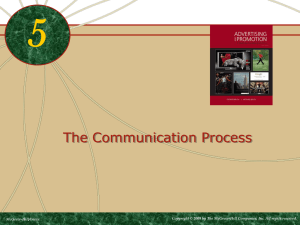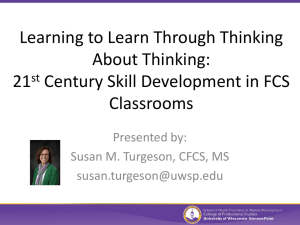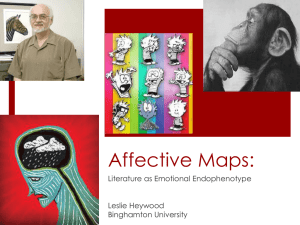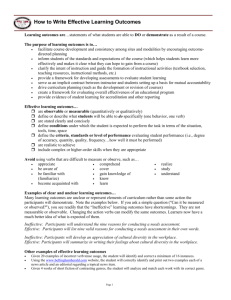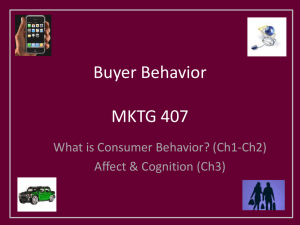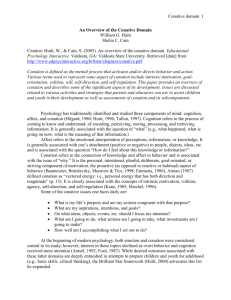Domains - RCampus
advertisement
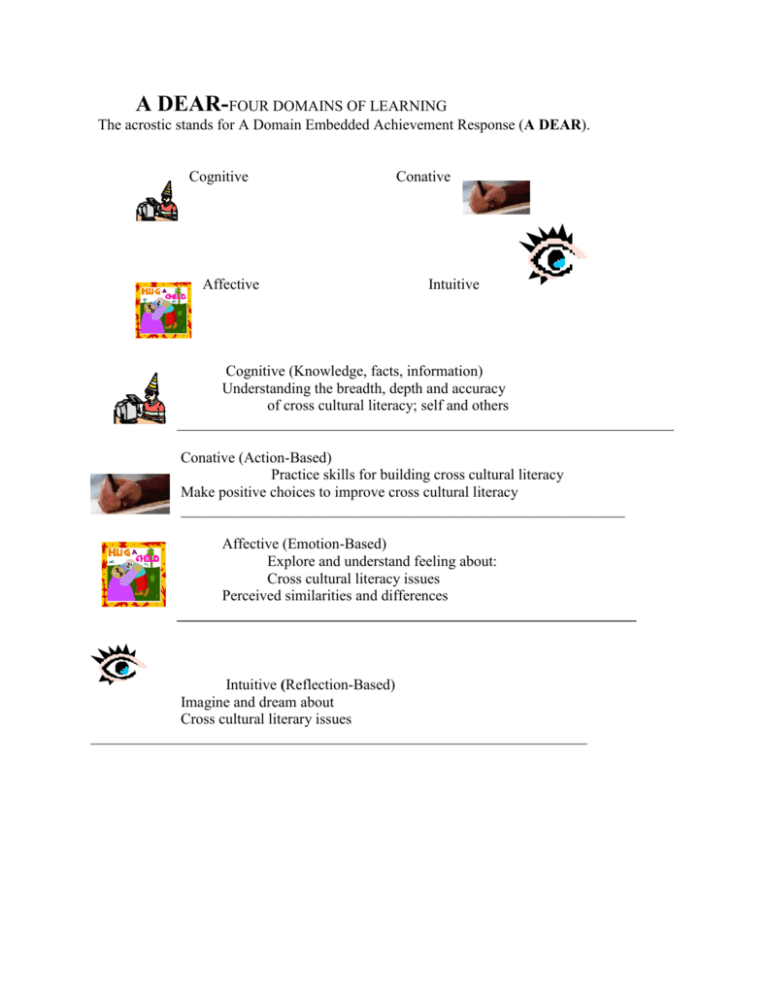
A DEAR-FOUR DOMAINS OF LEARNING The acrostic stands for A Domain Embedded Achievement Response (A DEAR). Cognitive Affective Conative Intuitive Cognitive (Knowledge, facts, information) Understanding the breadth, depth and accuracy of cross cultural literacy; self and others __________________________________________________________________ Conative (Action-Based) Practice skills for building cross cultural literacy Make positive choices to improve cross cultural literacy ___________________________________________________________ Affective (Emotion-Based) Explore and understand feeling about: Cross cultural literacy issues Perceived similarities and differences _____________________________________________________________ Intuitive (Reflection-Based) Imagine and dream about Cross cultural literary issues __________________________________________________________________ The Domain Descriptors It is important that school leaders and students understand how motivational factors influence student behaviors when dealing with the challenge of school achievement. The ten essential principles for African American student achievement stress the issue of personal responsibility for moral action. When addressing African American achievement and the need for moral action, there are at least four areas of focus in the process of development. These are the cognitive, affective, conative and intuitive domains. Merenbloom (1991) described the cognitive domain as "organized thought processes." It is closely aligned to the knowledge and skills that humans possess. It is the commonly expressed goal of public education. An effective character education process will aid the development of students’ problem solving, critical, analytical, and creative thinking through enriched opportunities and experiences in interdisciplinary learning. Character education goes beyond just the academic skills. Huitt (1999) proposed that “cognition refers to the process of coming to know and understand; the process of encoding, storing, processing, and retrieving information. It is generally associated with the question of what (e.g., What happened; what is going on now; what is the meaning of that information?).” “Students at Promise” have difficulty activating their background knowledge and coordinating it with new information. There are three kinds of cognition that learners utilize. These are declarative knowledge or the “what” one needs to know; the procedural “how” one can problem solve; and the conditional “when” does one put the others to use? Bloom (1974) classified the process of cognition into levels starting with knowledge, comprehension, application, analysis, synthesis, and evaluation. Favors and Favors (1994) shared the view of Taba’s Concept Formation. It is a strategy to help students develop inductive thinking through using categories and teaching students to categorize. This is higher level thinking. - Thinking can be taught. There is active interaction between data and individuals. Processes of thought evolve in a correct sequence. The affective domain according to George & Alexander (1993) is used to help students “in the development of desirable attitudes, values, and moral judgments. It involves the emotions and revolves around the feelings and motivations that govern the Conative behaviors.” Students At Promise find it easier to learn in an environment which is warm and inviting. An environment that taps into their need for emotional stability. The affective domain according to Huitt (1999) “refers to the emotional interpretation of perceptions, information, or knowledge. It is generally associated with one’s attachment (positive or negative) to people, objects, ideas, etc. and asks the question, How do I feel about this knowledge or information?” Goleman (1995) stated that it is a complex and critical area for school success. The construct of emotional intelligence has several components including both affective (e.g., empathy, optimism, managing emotions) and conative (e.g., setting goals, selfregulation) domains. Maslow's (1954) framework related the three earliest developmental needs physiological, safety, belonging) within the affective domain. The conative domain relates to behaviors and issues of human learning. In Good’s Dictionary of Education, conation is defined as “striving or having the power to strive or struggle toward a goal which may be conscious or unconscious; descriptive of one of the three great divisions of the mind or soul (historically), namely, the will, as contrasted with terms descriptive of the feeling (affective) or the power of knowing (cognitive).” From the time we are born we have the desire to reach for the mobile in the crib. We take one more baby step to go into the next room. The innate desire to learn is born in us, but somewhere along the way it may be diminished. The conative domain aims at the behavior traits that cause action and volition (Huitt 1999). The desire, will, and "hands-on" action of students are the main thrust of this domain. After students are taught an academic skill, they may use the conative domain to help reinforce learning by engaging in an experiment, service learning project, or hands-on activity. There is a connection of knowledge and affect to behavior through the conative (Huitt 1999). It is associated with answering the question "why." Behavior skills are “necessary to accurately process the information contained in social encounters, to engage in thoughtful social decision making, and to be able to approach others in difficult situations without provoking anger or annoyance.” (Elias et al.1997). Kolbe (1990) offered a conative style, which might compare to temperament or personality type (Keirsey 1998) as a preferred method of linking cognition and affect to actively responding to the environment. Gholar (1991) examined the role of the conative domain in the attainment of student achievement. The conative domain directs learner toward an allconsuming desire to achieve. It is propelled with doubt about a self-directed sense of purpose in an atmosphere of challenge and cognitive disharmony. Counselors and educational leaders need to understand the correlation between the will to do and school performance. When learning is nurtured by the support of caring and responsive professionals, the desire to achieve is heightened. Thus, the affective/cognitive connection is buttressed to a level where students become empowered to reach beyond themselves. The power of the affective/cognitive connection is unleashed when school counselors and other educational professionals factor in the role of conation in the formula for school success. Through understanding the role of the learners’ will, desire, and determination to achieve in an academic setting, educators can more clearly understand the significance of using their skills as change agents to activate student success. When viewed as an integral part of a sound educational plan for developing competent and caring young people, students will emerge from our educational institutions with a healthy sense of self, their abilities, and the world around them. Huitt (1999) suggested some of the conative issues one faces daily are: What are my intentions and goals; what am I going to do; and what are my plans and commitments? Conation is necessary to explain how knowledge and emotion are translated into behavior in human beings. One reason researchers in the areas of cognition and attitudes have not demonstrated a strong ability to predict behavior is because the construct of conation has been omitted. At the beginning of modern psychology, both emotion and conation were considered central to its study; however, interest in these topics declined as overt behavior and cognition received more attention. The intuitive domain can be seen as similar to terms pertaining to internal attention, "introspection,"and "internalization." Jung used two interesting literary elements to show the word "intuition" (N). He said intuition, is "listening to the inner voice", heeding the prompts from inside our minds. Intuition is, in actuality, internal attention. We give attention to what is going on within ourselves using our mind's eye and our mind's ear, these prompts come as thoughts and feelings. Intuition refers to the process of predicting, making inferences, imagining, daydreaming, musing, or wondering; the introspection, or internalization about things not in visible to the naked eye. It can be associated with the question of what if (e.g., What if ... happened; What would happen if..?)” . Together these domains influence how well the “Student At Promise” is able to take advantage of the learning environment and how well he is able to meet the task of stemming violence and negative behaviors. These interconnected domains can work in concert to provide a positive individual learning atmosphere. The Domains may be illustrated as the following: Cognitive Skills Knowledge Problem Solving Critical Thinking Creative Thinking Analytical Thinking Learning Affective Emotions Attitudes Beliefs Motivations Affiliations Relationships Values Conative Will Desire Effort Experiences Doing Habits Activities Intuitive Introspection Reflection Daydreaming Musing Wondering Curiosity Inner focus
